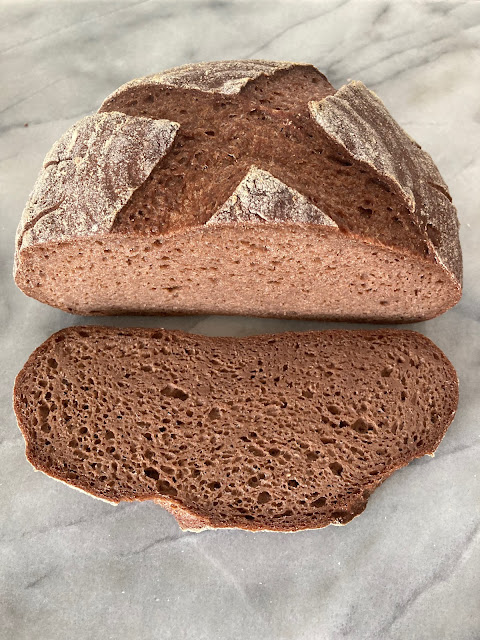One-Step Sourdough Bread Recipe
I've been baking quite a bit of bread lately, and I thought it was high time to share some new bread recipes. Almost a year ago I posted a very popular recipe for a traditional two-step, 24 hour sourdough bread. I love that recipe, and I think that it makes a really delicious, sour bread. However, sometimes I want my bread to come out less sour, or I just don't have the time to do the two-stage sourdough process. This is the recipe I use for a bread that only takes one rise - then it's shaped and baked.
1-Step Sourdough Bread Recipe
First mix: 10 minutes
First rise: 6-12 hours
Bake time: 45 minutes
Whisk together until blended in the bowl of a stand mixer with the paddle attachment, or in a large bowl with a fork:
460 g Spring Water (don't use tap water or any chlorinated water)
30g whole psyllium husk (or 20g finely ground psyllium husk)
Mix into the liquid with the paddle attachment or by hand with a wooden spoon:
100g wild yeast Sourdough Starter
12g (1 TBSP) sugar
1 1/4 tsp salt
Pre-shape the dough into a ball and keep it seam-side up in the bowl. Cover the bowl with plastic wrap and let stand at room temperature for 6-12 hours. Keep an eye on it starting at the 6 hour mark.
When the bread has risen significantly and you think it's getting close to time, heat your oven to 450 degrees F with a cast-iron dutch oven inside. You will know the bread is ready to bake when it has risen quite a bit and a finger mark gently poked against the surface of the dough doesn't fill in immediately anymore. Once it passes the "finger test" and the oven is hot, you can shape the loaf, although it's better to under-proof a little than over-proof. (If you need to go longer than 12 hours on the rise, put the dough in the refrigerator after the bread shows a significant rise. You can leave it in fridge for up to a day or maybe three, then shape and bake.)
Carefully invert the bread onto a piece of parchment paper. Shape the bread into a slightly tighter ball by tucking the sides of the dough underneath all around the edge. Dust the top with flour if desired. Score the loaf with slashes 1/2 inch deep.

Using the parchment paper to lift it, carefully place the shaped loaf inside the hot dutch oven. Spritz the bread and all around the cast-iron pan before covering it with the lid. Bake the bread for 25 minutes inside the dutch oven, then remove to the rack and bake another 20 minutes or until deeply browned. Remove the bread to cool on a rack, or for a crispier crust let it cool in the oven with the door propped ajar.
Enjoy some authentic sourdough bread!









Comments
what does it mean: @120% hydration?
100g wild yeast Sourdough Starter (@120% hydration)
I have already baked several GF sourdough loaves.
I made these breads according to the recipes of Bakerita, Natasha and Cannelle et Vanille.
In each recipe, the breads are baked fo r an average of about 1:15 to 1:30 hours.
I see that you use shorter baking times. I have also baked a loaf of bread in an hour, but it remained very dense/wet and gummy. Why do you keep a shorter baking time? Doesn't the bread remain very wet?
Kind regards from the Netherlands!
I just wondered if it would be possible to leave the sugar out? I scrolled your recipes and they are great but I can not have sugar, at all :( Is the sugar there for taste or does it have other purposes? Greetings